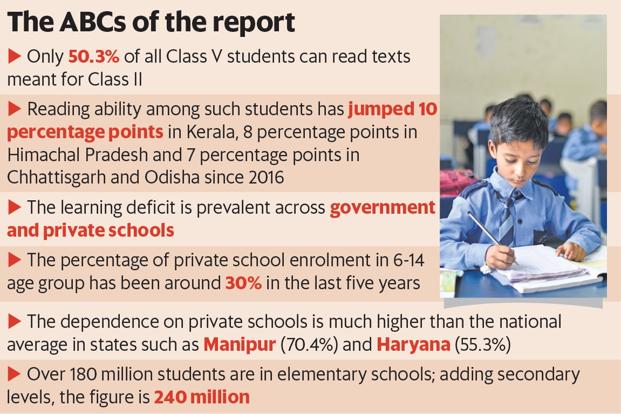Why in news?
Annual Status of Education Report 2018, released recently, finds some improvements in primary education.
What is the background?
- The Annual Status of Education Report (ASER) is being released by a non-governmental organisation Pratham since 2005.
- Each year’s report has been presenting a dismal picture of primary education in India.
- The reports focus on children aged between 6 years and 14 years in rural India.
- It maps the schooling status of and the impact of primary education on a child’s ability to complete basic reading and arithmetic tasks.
- Despite enacting Right to Education in 2010, which has mandated free and compulsory education for each child between the age of 6 and 14 years, learning outcomes remained poor.
What does the latest report reveal?
- For the first time since India adopted RTE, reading abilities of Class V students in government schools have improved and their basic mathematical abilities have started growing faster.
- For instance, the proportion of government school students in Class V, who can read a Class II-level text has risen from 41.7% in 2016 to 44.2% this year.
- This ratio had been declining from 53.1% in 2008.
- Similarly, 27.3% of students in Class III can now read a Class II text, up from 21.6% in 2013.
- India has also moved further ahead on gender parity, wherein the proportion of girls in the age group of 11-14 years who stayed out of school declining from 6% in 2010 to 4.1% in 2018.
- Moreover, it is the first time that the proportion of children not enrolled in schools has fallen below 3%.
- Also, among states, the reading ability among Class V students in Kerala jumped 10 percentage points in 2018 from that in 2016.

- In Himachal Pradesh, the growth is nearly 8 percentage points and in Chhattisgarh and Odisha it is around 7 percentage points between 2016 and 2018.
- Still, data from states such as Jharkhand, West Bengal, Gujarat, Rajasthan and Tamil Nadu shows a marginal dip in the same criterion for the same cohort.
What are the concerns?
- Despite these developments, the broader trend is still worrying.
- The basic reading and mathematics abilities of children in Class VIII continue to slowly decline.
- For instance, among Class VIII students attending government schools, the proportion that can read a Class II text has continued to decline from 83.6% a decade ago to 69% in 2018.
- The proportion is similar when it comes to mathematical abilities.
- The picture is slightly more encouraging at the Class III level, where there has been gradual improvement since 2014.
- However, even in 2018, less than 30% of students in Class III are actually at their grade level, that is, able to read a Class II text and do double-digit subtraction.
- The performance in private schools is better than government schools.
- In fact, in private schools, reading and mathematical abilities for students in both Class V and Class VIII have shown improvement.
- However, the performance difference is not great as learning deficit is present across both government and private schools.
- Traditionally, students in private schools have fared better than their government school counterparts, but that’s a relative situation.
- For example, while 40% of Class VIII students in government schools can do simple division, the figure is only 54.2% in private schools.
- Private school students are believed to have better family background, both in economic and education front, which serves as a key differentiator.
- This means the improvements in educational achievements are not broad-based.
- In particular, higher primary (class VI to Class VIII) have not shown enough improvements.
- Thus, the report shows the prevalence of learning deficit and the poverty of basic reading and arithmetic skills among students in Indian schools.
Why is learning level in schools important?
- The quality of the learning level bears directly on India’s future workforce, its competitiveness and the economy.
- India’s demographic dividend depends on the learning level of students.
- Since children at the higher primary level is closest to joining the labour market or the next level of education, they need adequate foundational skills such as literacy and numeracy.
- Thus, it can be revealed from the latest report that India continues to stare at a crisis and hence need concerted efforts to be taken at the earliest.
Source: Business Standard
